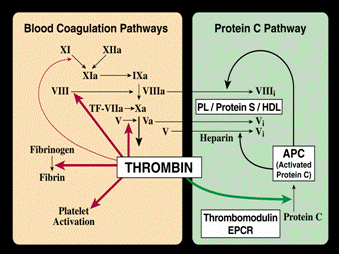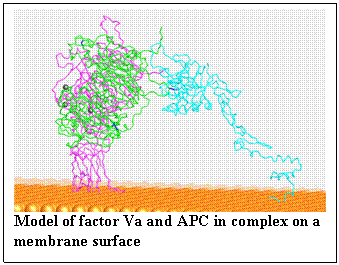Research
Our lab is interested in structure function relationships in proteins of the coagulation pathway. We utilize molecular biology, biochemistry and, in collaboration with the Getzoff
 lab here at TSRI, computer modeling to investigate protein-protein interactions and functional properties of coagulation factors. Additionally, we hope to utilize this knowledge to direct protein engineering with the purpose of creating altered coagulation factors that could provide improved therapeutic benefit.
lab here at TSRI, computer modeling to investigate protein-protein interactions and functional properties of coagulation factors. Additionally, we hope to utilize this knowledge to direct protein engineering with the purpose of creating altered coagulation factors that could provide improved therapeutic benefit.
We have focused on the anticoagulant activated protein C (APC) pathway and the coagulation cofactors, factor Va (FVa) and factor VIIIa (FVIIIa), which APC inactivates. As a member of the Griffin lab at TSRI, I analyzed the interactions of APC with FVa and modeled the FVa structure and the APC/FVa interaction. My current focus is on FVIII.
Deficiency of the blood coagulation factor VIII is responsible for the hemorrhagic bleeding disorder hemophilia A. Hemophilia A is an X-linked genetic disorder and affects approximately 1 in 5000 males. FVIIIa, the activated form of FVIII, is the cofactor for FIXa in the intrinsic pathway of the coagulation system. Though the severity of hemophilia varies depending on the mutation causing the defect of FVIII, in all cases there are risks of life-threatening bleeding episodes and also risks of permanent disability as a result of chronic bleeding into muscles and joints. Hemophilia A is now mostly controlled by infusions of purified plasma-derived or recombinant FVIII. However, these treatments are expensive and plasma-derived clotting factors carry some risk of viral transmission.
coagulation system. Though the severity of hemophilia varies depending on the mutation causing the defect of FVIII, in all cases there are risks of life-threatening bleeding episodes and also risks of permanent disability as a result of chronic bleeding into muscles and joints. Hemophilia A is now mostly controlled by infusions of purified plasma-derived or recombinant FVIII. However, these treatments are expensive and plasma-derived clotting factors carry some risk of viral transmission.
We have created recombinant variants of FVIII that yield activated FVIII with increased functional stability which could result in improved therapeutic agents for treatment of hemophilia A. Our variants overcome the inherent instability of FVIIIa caused by spontaneous dissociation of the A2 subunit. We are working with these FVIII variants to define their in vitro characteristics, which relate directly to their potential as therapeutic agents, and further, to characterize their in vivo function in a mouse hemophilia model.
The primary hypothesis is that creation of a disulfide bond between A domains of FVIII by genetic engineering will prevent spontaneous dissociation of the A2 subunit from heterotrimeric FVIIIa and thereby, result in a more stable FVIIIa molecule. We identified several possible locations for disulfide bonds that could crosslink the A2 domain to the A3 domain and created two separate double-cysteine mutants of FVIII that would allow for formation of the proposed disulfide bonds. Characterization of these variants indicates that they form new disulfide bonds and have increased stability following activation by thrombin.



